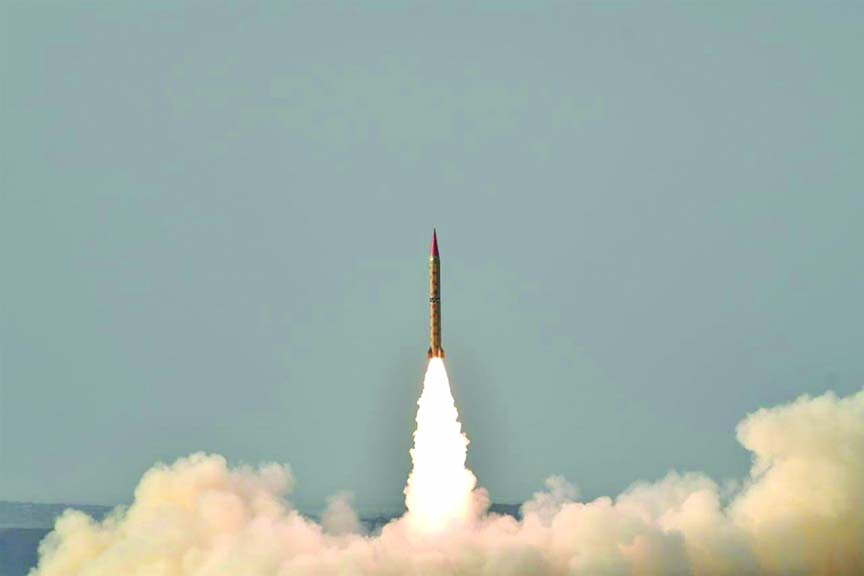
Reuters, Islamabad :
Pakistan has signalled a willingness to open peace talks with India as Prime Minister Narendra Modi appears set to return to power after the national elections were fought in the shadow of renewed confrontation between the nuclear-armed enemies.
But in a possible warning, Pakistan also announced that it has conducted a training launch of a Shaheen II, surface-to-surface ballistic missile, which it said is capable of delivering conventional and nuclear weapons at a range of up to 1,500 miles.
“Shaheen II is a highly capable missile which fully meets Pakistan’s strategic needs towards maintenance of deterrence stability in the region,” Pakistan’s military said in a statement that made no direct mention of its neighbour.
But in a possible warning, Pakistan also announced that it has conducted a training launch of a Shaheen II, surface-to-surface ballistic missile, which it said is capable of delivering conventional and nuclear weapons at a range of up to 1,500 miles.
“Shaheen II is a highly capable missile which fully meets Pakistan’s strategic needs towards maintenance of deterrence stability in the region,” Pakistan’s military said in a statement that made no direct mention of its neighbour.
On Wednesday, Pakistani Foreign Minister Shah Mehmud Qureshi spoke briefly with his Indian counterpart at the sidelines of a meeting of the Shanghai Cooperation Organization member states in the Kyrgyz capital, Bishkek.
“We never speak bitterly, we want to live like good neighbours and settle our outstanding issues through talks,” he said following the meeting.
The remark follows months of tension between the two neighbouring countries after terror attack in Jammu and Kashmir’s Pulwama killed 40 CRPF men. The terror attack was claimed by Pakistan-based terror group Jaish-e-Mohammed.
India then carried out “non-military, pre-emptive” air strikes on a Jaish terror training camp in Pakistan’s Balakot on February 26.
The next day, after an aerial combat between the two countries, the Indian Force Pilot was captured. His MiG -21 Bison fighter plane was shot down when he was chasing Pak jets in Jammu and Kashmir and crossed over to Pakistan-occupied Kashmir (PoK). He ejected safely and was taken into custody by the Pakistan Army.
He was released two days later by Pakistan amid global pressure.
There were no further strikes but tensions remained high, with regular exchanges of artillery fire from both sides.
Pakistan has also kept part of its airspace closed to international air traffic, disrupting flights to India and other parts of the region.
Pakistan Prime Minister Imran Khan has repeatedly offered to start talks with India to resolve the Kashmir issue, and officials have said that they hoped the process could start once the election is concluded.
Mr Khan himself said last month he believed there was more prospect of peace talks with Indian if Modi’s Hindu nationalist Bharatiya Janata Party (BJP) won the election. The ballistic missile is capable of delivering multiple types of warheads up to a distance of 290 kms, the Pakistani military’s media spokesperson, Major General Asif Ghafoor wrote on Twitter.
According to experts, the Ghaznavi missile could be an improved ‘Scud’ type ballistic missile. The missile’s warhead can be conventional, high explosive (HE) and nuclear.
Maj Gen. Ghafoor said that the Pakistan Chairman Joint Chiefs of Staff Committee (CJCSC) and the three services chiefs congratulated the team of experts for successfully testing the missile.
Pakistan’s President Arif Alvi and Prime Minister Imran Khan also conveyed their appreciation to the team, and congratulated the nation on the feat, he said.
The nuclear-capable missile was launched amid Pakistan’s efforts to internationalise the Kashmir issue after India abrogated provisions of Article 370 of the Constitution to revoke Jammu and Kashmir’s special status and bifurcated it into two Union Territories.
Pakistani Prime Minister Imran Khan has repeatedly raised the threat of a nuclear war in the region as a result of India’s sovereign and constitutional decision on Jammu and Kashmir.
Pakistan expelled the Indian High Commissioner after it downgraded the diplomatic ties with India. Pakistan also suspended its trade with India and stopped the cross-border train and bus services.
India has categorically told the international community that the scrapping of Article 370 was an internal matter and also advised Pakistan to “accept the reality”
Pakistan and India are among a small handful countries with nuclear arsenals. India joined the nuclear club long before Pakistan, in 1974, prompting Islamabad to follow suit.
Pakistan silently developed its own nuclear capability in the 1980s, when it was an ally of the U.S. in the first Afghan war against the crumbling Soviet Union.
It did not conduct any nuclear tests until India carried out a series of its own tests in 1999. Only three weeks later, Pakistan conducted six successful tests in the remote Chaghi district near the Afghanistan-Iran border, stoking fears of a nuclear war between the longtime rivals.
According to Stockholm International Peace Research Institute, India currently possesses between 80 and 100 nuclear warheads, while Pakistan holds between 90 and 110..
President Arif Alvi and Prime Minister Imran Khan conveyed their appreciation to the team, and congratulated the nation on the feat, he said.
PM Imran Khan has been hinting at nuclear war ever since Pakistan decided to downgrade relations with India
Pakistani Prime Minister Imran Khan once again spoke of a nuclear war.
Earlier in May, Pakistan conducted a successful training launch of Shaheen-II, a surface-to-surface ballistic missile.
In January, Pakistan successfully launched the tactical ballistic missile Nasr as part of the Army Strategic Forces Command training exercise.

